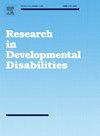Development of the Difficulties in Communicating with Teachers Scale Among Parents of Children with ADHD
IF 2.6
2区 医学
Q1 EDUCATION, SPECIAL
引用次数: 0
Abstract
Background
Parents of children with attention-deficit/hyperactivity disorder (ADHD) experience difficulties in communicating with teachers about the challenges their children face with respect to learning, interpersonal relationships, behaviors, and emotions. The current study developed the Difficulties in Communicating with Teachers Scale Among Parents of Children with ADHD (DCT-P-CADHD) and analyzed its psychometric properties.
Methods
The DCT-P-CADHD was developed on the basis of data from focus group interviews. An exploratory factor analysis using principal axis factoring and polychoric correlation was conducted to examine the factor structure of the DCT-P-CADHD in 230 parents of children with ADHD. Internal consistency was assessed using Cronbach’s α and McDonald’s ω on polychoric correlations. The 1-month test–retest reliability and item–rest correlation were assessed using Pearson correlation. Concurrent validity was determined by examining the correlations of DCT-P-CADHD scores with Center for Epidemiologic Studies Depression Scale (CESD) and Swanson, Nolan, and Pelham Rating Scale-IV (SNAP-IV)-Parent Form scores.
Results
One factor was extracted for the DCT-P-CADHD. The DCT-P-CADHD had high internal consistency (α = 0.973 and ω = 0.981), strong item–rest correlations (range of Pearson correlation: 0.602–0.899), and acceptable test–retest reliability (Pearson correlation: 0.809). The scale score was significantly correlated with CES-D scores (r = 0.385) and SNAP subset scores (r = 0.294–0.322).
Conclusion
Our findings provide support for the psychometric properties of the DCT-P-CADHD. Thus, the DCT-P-CADHD can be used to evaluate parental difficulties in communicating with teachers about the issues faced by their children with ADHD.
开发多动症儿童家长与教师沟通困难量表
患有注意力缺陷/多动障碍(ADHD)儿童的家长在与老师沟通他们的孩子在学习、人际关系、行为和情绪方面面临的挑战时遇到困难。本研究编制了ADHD儿童家长与老师沟通困难量表(DCT-P-CADHD),并对其心理测量特性进行了分析。方法采用焦点小组访谈法编制DCT-P-CADHD量表。采用主轴因子分析和多元相关法对230例ADHD患儿家长DCT-P-CADHD的因子结构进行探索性因子分析。采用Cronbach’s α和McDonald’s ω对多重相关进行内部一致性评估。1个月测试-重测信度及项目-休息相关采用Pearson相关评估。通过检验DCT-P-CADHD分数与流行病学研究中心抑郁量表(CESD)和Swanson, Nolan, and Pelham评定量表- iv (SNAP-IV)-家长表格分数的相关性来确定并发效度。结果提取了影响DCT-P-CADHD的一个因素。DCT-P-CADHD具有较高的内部一致性(α = 0.973, ω = 0.981)、较强的项目休整相关性(Pearson相关范围为0.602 ~ 0.899)和可接受的重测信度(Pearson相关为0.809)。量表评分与CES-D评分(r = 0.385)和SNAP子集评分(r = 0.294-0.322)显著相关。结论本研究结果为DCT-P-CADHD的心理测量特性提供了支持。因此,DCT-P-CADHD可以用来评估家长在与老师沟通ADHD儿童面临的问题时遇到的困难。
本文章由计算机程序翻译,如有差异,请以英文原文为准。
求助全文
约1分钟内获得全文
求助全文
来源期刊

Research in Developmental Disabilities
Multiple-
CiteScore
5.50
自引率
6.50%
发文量
178
期刊介绍:
Research In Developmental Disabilities is aimed at publishing original research of an interdisciplinary nature that has a direct bearing on the remediation of problems associated with developmental disabilities. Manuscripts will be solicited throughout the world. Articles will be primarily empirical studies, although an occasional position paper or review will be accepted. The aim of the journal will be to publish articles on all aspects of research with the developmentally disabled, with any methodologically sound approach being acceptable.
 求助内容:
求助内容: 应助结果提醒方式:
应助结果提醒方式:


